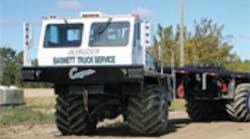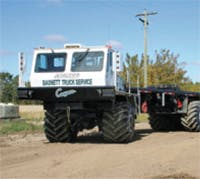Using Petro-Canada’s Hydrex XV All Season hydraulic fluid provided Basnett Truck Service with extra wear protection for its equipment and eliminated seasonal changeouts.
The company’s equipment fleet is made up of eight bed trucks, two offroad units, and 22 haul trucks — all of which are called upon to perform under extreme off-road conditions. These conditions include carrying severe loads up the side of a mountain, temperatures ranging from –40°C to 30°C and thick, boggy, and dusty oil field environments.
To ensure peak equipment performance and protection, president Vern Basnett relies on a strict maintenance and service protocol, which includes the use of Petro-Canada lubricants.
A fluid for all seasons
Basnett needed a lubricant line that would collectively help reduce downtime, extend drain intervals, and perform throughout extreme temperatures and conditions. He also wanted environmental efficacy and a bulk system (when a bench tank and pumps are provided and monitored by an oil supplier), which has resulted in less waste, less handling, and less packaging to dispose of.
“We switched to Petro-Canada lubricants back in July of 2003,” says Basnett. “We now use Hydrex XV All Season hydraulic fluid in all of our hydraulic systems. It helps ensure my equipment performs in some of the most extreme conditions in the trucking industry.”
“Before switching to Hydrex, warm-up time in the winter was 15 minutes. Now, it’s three minutes,” Basnett says. “And in the summer, oil temperature is as much as 20° cooler.”
Hydrex All Season is recommended for year-round use in equipment that must perform in low and high temperature ranges. Hydrex XV provides optimal viscosity in the hydraulic pump at temperatures as low as –40°F, so the pump is more responsive. As a result, the fluid does not become too thin at high operating temperatures or too thick at cold-start up temperatures.
In addition, it offers high fluidity at cold temperatures, allowing the oil to flow more readily, thus creating pressure for the hydraulic pump to operate, says Jennifer Lai, category manager, Hydraulics & Forestry Products for Petro-Canada. This also relates to having the right viscosity based on temperature. For example, if oil is too thick at cold temperatures, it won’t flow adequately; therefore it is not “fluid” enough.
A typical hydraulic pump may convert up to 20% of its horsepower into heat. Therefore, most fluids may run at elevated temperatures. Lai says that switching fluids reduced the operating temperature because Hydrex XV provides optimal viscosity in the hydraulic pump at high operating temperatures, which results in reduced friction and wear on equipment components.
Stable in hot and cold
Viscosity index (VI), an indicator of an oil’s ability to resist changes in viscosity due to temperature changes, is an important characteristic for a hydraulic fluid. The higher the VI, the less the oil’s viscosity will be affected by temperature changes.
For hydraulic equipment subject to a wide range of operating temperatures, high viscosity index fluids are essential to reduce leakage, eliminate sluggish operation, and increase overall operating efficiency.
For information, call Petro-Canada at (888) 284-4572 or visit lubricants.petro-canada.ca.


